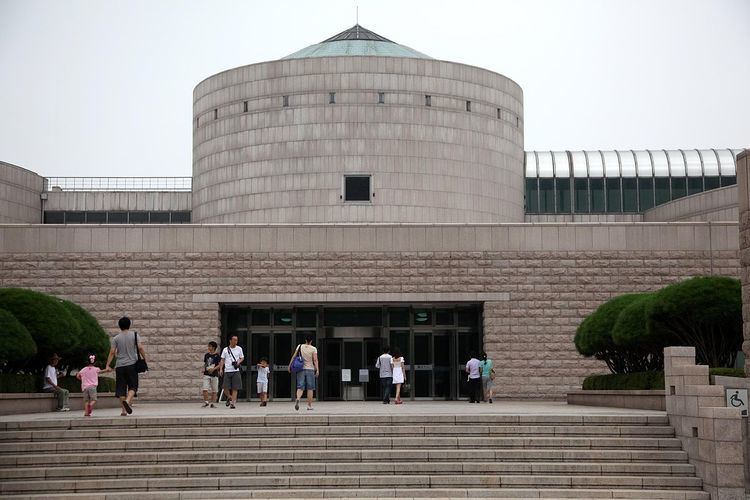Established 1969 Hangul 국립현대미술관 Phone +82 2-2022-0600 | Website Official website Director Bartomeu Mari Date founded 1969 | |
 | ||
Location Gwacheon main -313 Gwangmyeong-ro, Gwacheon-si, Gyeonggi-do, South KoreaDeoksugung branch -99 Sejong-daero, Jung-gu, Seoul, South KoreaSeoul branch -30 Samcheong-ro, Sogyeok-dong, Jongno-gu, Seoul, South KoreaCheongju (expected opening 2019) Address 99, Sejong-daero, Jung-gu, Seoul, South Korea Hours Open today · 10AM–9PMWednesday10AM–9PMThursday10AM–7PMFriday10AM–7PMSaturday10AM–9PMSunday10AM–7PMMondayClosedTuesday10AM–7PMSuggest an edit Similar National Museum of Contemp, Deoksugung, Museo nacional de arte m, Seoul Museum of Art, Leeum - Samsung Museum Profiles | ||
National museum of modern and contemporary art mmca seoul south korea
The National Museum of Modern and Contemporary Art, Korea (MMCA) is a contemporary art museum with the main museum in Gwacheon and three branches each in Deoksugung, Seoul and Cheongju. The museum was first established in 1969 as the only national art museum in the country accommodating modern and contemporary art of Korea and international art of different time periods.
Contents
- National museum of modern and contemporary art mmca seoul south korea
- National museum of modern and contemporary art korea seoul 3d video
- History and Architectural style
- Collections and Exhibitions
- Departments
- Controversies
- References
National museum of modern and contemporary art korea seoul 3d video
History and Architectural style
The National Museum of Contemporary Art (MMCA), also known as Gwacheon Contemporary Art Museum, is located in Gwacheon, South Korea. The museum was initially established in Gyeongbokgung on October 20, 1969, but was moved to Deoksugung in 1973. It was moved to its current location in 1986. Founded to contribute to the development of Korean contemporary art by systematically conserving and exhibiting artworks created since 1910, the museum’s area of 73,360㎡ spreads over three floors, and has an outdoor sculpture park occupying 33,000㎡. The motif of the architecture is that of a traditional Korean fortress and beacon mound, and the building has a unique spiral- formed interior where Dadaigseon, one of the most famous video artworks by Nam June Paik, is located.
The first branch of the MMCA was established in 1998 in Seokjo-jeon of Deoksugung (Jeong-dong, Jung-gu, Seoul, South Korea), in order to further increase the museum’s accessibility for people living in the northern part of Seoul. The museum has four exhibition halls, rest zones and art shops, and the total area is approximately 3,428㎡.
The Seoul branch of the museum opened in November 13, 2013, next to Gyeongbokgung. Built on and next to the former Military Defense Security Command building, the architectural design adopted the madang (yard) concept, which successfully integrated the exterior and interior of the building to the surrounding environment. The madang also serves as a public leisure space as well as a space to hold outdoor artistic events and programs.
The third branch of the MMCA is currently under construction in Cheongju-si, Choongcheongbuk-do, South Korea, with its prospective opening in 2016. The purpose of the third branch is not only to conserve artworks, but also to train people in art conservation.
Collections and Exhibitions
The collections of the main museum in Gwacheon includes around 7,000 artworks including works of contemporary Korean artists such as Go Hui-dong, Ku Bon-ung, Park Su-geun, and Kim Whan-ki. The museum has also gathered a substantial internationally recognized collection including artworks by Joseph Beuys, Andy Warhol, Georg Baselitz, Jörg Immendorff, Marcus Lüpertz, Nam June Paik, Nikki de Saint-Phalle, Jonathan Borofsky, and Michelangelo Pistoletto.
Past exhibitions include the installation of Sinseon Play - Moon Ji Bang as a part of the Young Architects Program at MoMA and MoMA PS1 in 2014. In 2011, the MMCA hosted the exhibition The American Art, which was “the first occasion to exhibit the Collection of Whitney Museum, in Asia,” featuring artists such as Jeff Koons, Andy Warhol, and Jasper Johns. Likewise in 2010, the museum hosted the exhibition Picasso and Modern Art, which was the first exhibition of collections from the Albertina Museum (Vienna, Austria) in an East Asian country. In addition to loan exhibitions, the MMCA has mounted special exhibitions of Korean art, such as Acquisitions in Korean Art 1960-1980, and Masterpieces of Korean Modern Art: Exploration of Modern History in 2008.
Departments
The MMCA has various art education programs including professional education programs for curators, employees of museums, art teachers, and college students. The Children’s Museum is located in Gwacheon main museum, where programs for elementary students, disabled students and students from poor neighborhoods are held. There is also a special support program for young artists, called ‘Residency,’ in which the museum provides studios for selected young artists and holds art conversations among artists and art professionals.
The conservation center of the museum was first established in 1980. The center has been working to develop its modern techniques for conservation by holding exchange programs with overseas conservation centers. Currently, the center is divided into four professional departments: oil paintings, Korean traditional artworks, contemporary sculptures, and medium of artworks. Furthermore, the museum opened its ‘art research center’ in 2013, which focuses on the research of East Asian contemporary art.
Controversies
Shortly after its opening, members of the Korean Fine Arts Association and other artist organizations protested over the selection of art for inclusion, charging the Director, a graduate of Seoul National University, with a bias toward graduates of that school, noting that 32 of the 39 artists represented in the exhibition Zeitgeist Korea are from his alma mater.
